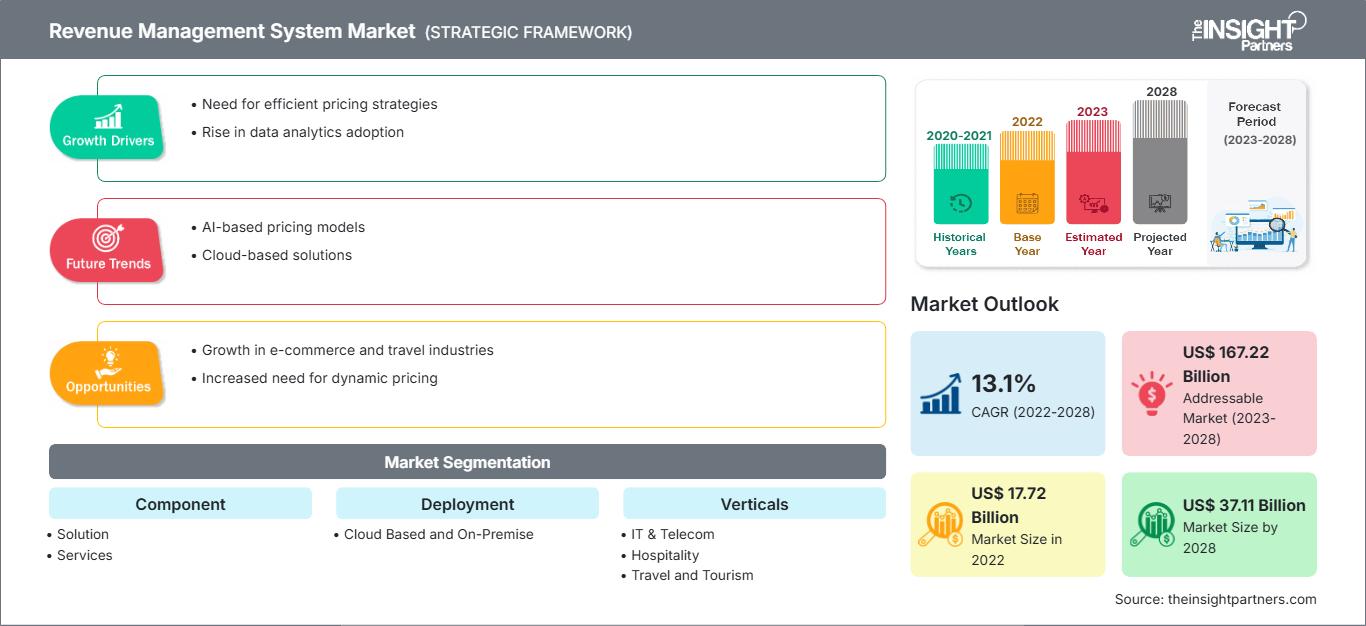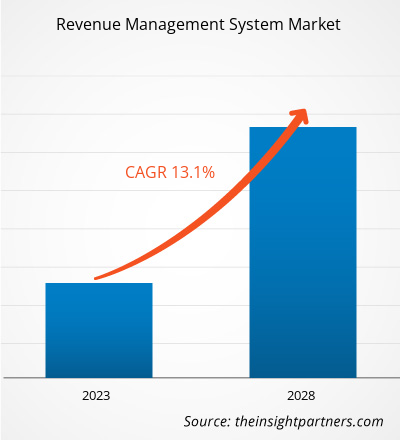Si prevede che il mercato dei sistemi di gestione delle entrate crescerà da 17.717,02 milioni di dollari nel 2022 a 37.106,75 milioni di dollari entro il 2028; si stima una crescita a un CAGR del 13,1% dal 2022 al 2028.
Un sistema di gestione delle entrate include soluzioni e servizi che consentono alle aziende di incrementare le vendite con pagamenti automatizzati ed efficienti ai clienti e di ridurre le perdite di fatturato. Con l'ausilio di automazione e analisi, il software di gestione delle entrate mira a massimizzare i ricavi e la redditività. Le soluzioni e i servizi offerti da un sistema di gestione delle entrate si integrano sia con i software di contabilità che con i sistemi ERP. Questo sistema integra e analizza dati storici e di mercato per previsioni accurate, una migliore efficienza operativa, ecc. Inoltre, prevede il comportamento dei consumatori, ottimizza la disponibilità dei prodotti e velocizza i metodi di fatturazione e pagamento riducendo rischi e frodi. Negli ultimi anni, si è registrata una crescente domanda di ottimizzazione delle piattaforme di revenue e della gestione dei canali. Le operazioni aziendali dipendono sempre più dal cloud e dai sistemi di automazione avanzati. Pertanto, i crescenti aggiornamenti dei sistemi legacy di revenue e channel management esistenti e la crescente necessità di strategie di prezzo competitive stanno guidando la crescita del mercato dei sistemi di revenue management.
Il mercato dei sistemi di revenue management in Nord America è segmentato in Canada, Stati Uniti e Messico. Gli Stati Uniti rappresentano la quota maggiore del mercato dei sistemi di revenue management in Nord America. L'elevata penetrazione di Internet in tutta la regione è il fattore principale che catalizza l'adozione di soluzioni digitali in settori come IT e telecomunicazioni, media e intrattenimento, sanità, commercio al dettaglio ed e-commerce e assicurazioni. Diverse compagnie assicurative in tutto il paese propongono ai propri clienti una struttura di premi competitiva. Ciò sta influenzando l'adozione di soluzioni di revenue management tra le compagnie assicurative per l'analisi dei clienti e il calcolo dei premi in base alla concorrenza a livello nazionale. Inoltre, gli Stati Uniti registrano un numero enorme di turisti ogni anno, sia per lavoro che per piacere. Ciò ha avuto un impatto significativo sulla crescita del settore alberghiero in tutto il paese. Pertanto, diversi hotel e ristoranti di lusso stanno adottando diverse strategie per attrarre più clienti. Ciò contribuisce ulteriormente alla crescente domanda di sistemi di revenue management nel settore alberghiero del paese.
Personalizza questo rapporto in base alle tue esigenze
Potrai personalizzare gratuitamente qualsiasi rapporto, comprese parti di questo rapporto, o analisi a livello di paese, pacchetto dati Excel, oltre a usufruire di grandi offerte e sconti per start-up e università
Mercato dei sistemi di gestione delle entrate: Approfondimenti strategici

- Ottieni le principali tendenze chiave del mercato di questo rapporto.Questo campione GRATUITO includerà l'analisi dei dati, che vanno dalle tendenze di mercato alle stime e alle previsioni.
Potrai personalizzare gratuitamente qualsiasi rapporto, comprese parti di questo rapporto, o analisi a livello di paese, pacchetto dati Excel, oltre a usufruire di grandi offerte e sconti per start-up e università
Mercato dei sistemi di gestione delle entrate: Approfondimenti strategici

- Ottieni le principali tendenze chiave del mercato di questo rapporto.Questo campione GRATUITO includerà l'analisi dei dati, che vanno dalle tendenze di mercato alle stime e alle previsioni.
Impatto della pandemia di COVID-19 sulla crescita del mercato europeo dei sistemi di revenue management
La pandemia di COVID-19 ha causato enormi interruzioni nella crescita di vari settori in Spagna, Italia, Germania, Regno Unito e Francia. Le aziende in Europa hanno attraversato gravi difficoltà economiche, dovendo sospendere le proprie attività o ridurne sostanzialmente l'attività. Inoltre, la riduzione delle attività commerciali, come le partnership che hanno portato all'adozione di soluzioni di fatturazione e revenue management in diversi paesi, ha ostacolato la crescita del mercato dei sistemi di revenue management. Inoltre, per supportare la modernizzazione delle funzionalità di revenue management, i principali attori del settore cercavano di fornire un sistema di revenue management facile da usare che migliorasse l'ottimizzazione e l'automazione dei prezzi in tempo reale e offrisse la possibilità di ottimizzare l'inventario dell'intero portafoglio prodotti in modo olistico. Inoltre, si prevede che la domanda di sistemi di revenue management nel settore alberghiero aumenterà, poiché gli hotel continuano a pianificare un aumento dei ricavi a causa dell'impatto della pandemia sul settore. Pertanto, si prevede che l'impatto complessivo della pandemia di COVID-19 sul mercato europeo dei sistemi di gestione delle entrate sarà da basso a moderato.
Approfondimenti di mercato - Mercato dei sistemi di gestione delle entrate
L'utilizzo crescente di piattaforme di fatturazione e gestione delle entrate basate su abbonamento guiderà la crescita del mercato dei sistemi di gestione delle entrate nei prossimi anni
I sistemi di gestione delle entrate offrono flessibilità consentendo agli utenti di accedere da qualsiasi dispositivo e fornendo accesso a informazioni aggiornate. I sistemi di gestione delle entrate consentono alle aziende di ospitare i propri dati sul cloud. Le aziende devono dare priorità all'ottimizzazione mobile per evitare svantaggi competitivi. Pertanto, l'ottimizzazione di un sito web per la visualizzazione mobile garantisce che le pagine si carichino rapidamente e visualizzino i dati su diversi dispositivi mobili. Inoltre, i modelli di fatturazione e gestione delle entrate basati su abbonamento consentono ai clienti di pagare prodotti o servizi in base al loro utilizzo (pagamento a consumo). Inoltre, la standardizzazione e l'automazione dei processi di fatturazione e gestione dei ricavi basati su abbonamento sono coerenti e sicure e contribuiscono alla gestione di dati di alta qualità in termini di prodotto, cliente, diritti e partner, supportati da un'architettura applicativa integrata.
Approfondimenti sul mercato dei sistemi di revenue management verticali
In base al settore verticale, il mercato dei sistemi di revenue management è suddiviso in IT e telecomunicazioni, ospitalità, viaggi e turismo, vendita al dettaglio ed e-commerce, servizi bancari, assistenza sanitaria, assicurazioni, media e intrattenimento e altri. Il settore dell'ospitalità globale comprende ristoranti, hotel, casinò e parchi di divertimento. Il settore ha registrato una rapida crescita nel corso degli anni grazie al crescente tenore di vita della popolazione urbana nei paesi sviluppati e in via di sviluppo. I crescenti investimenti da parte di organizzazioni private e pubbliche per sviluppare ristoranti, hotel e parchi di divertimento con diverse strutture e servizi aggiuntivi stanno alimentando la domanda di soluzioni di revenue management da parte del settore. I proprietari di hotel utilizzano sistemi di revenue management per l'analisi dei prezzi, che li aiuta ulteriormente nelle strategie di prezzo basate sui prezzi della concorrenza. Ad esempio, happyhotel e Atomize offrono sistemi di revenue management appositamente progettati per gli albergatori. Queste soluzioni aiutano gli hotel ad analizzare i prezzi e il comportamento dei clienti, consentendo loro di progettare offerte personalizzate. Tutti questi fattori stanno guidando la crescita del segmento nel mercato dei sistemi di revenue management.
Gli operatori che operano nel mercato dei sistemi di revenue management adottano principalmente strategie di crescita inorganica per rimanere competitivi nell'ecosistema di mercato.
Approfondimenti regionali sul mercato dei sistemi di gestione delle entrate
Le tendenze regionali e i fattori che influenzano il mercato dei sistemi di Revenue Management durante il periodo di previsione sono stati ampiamente spiegati dagli analisti di The Insight Partners. Questa sezione illustra anche i segmenti e la geografia del mercato dei sistemi di Revenue Management in Nord America, Europa, Asia-Pacifico, Medio Oriente e Africa, America Meridionale e Centrale.
Ambito del rapporto di mercato sui sistemi di gestione delle entrate
| Attributo del rapporto | Dettagli |
|---|---|
| Dimensioni del mercato in 2022 | US$ 17.72 Billion |
| Dimensioni del mercato per 2028 | US$ 37.11 Billion |
| CAGR globale (2022 - 2028) | 13.1% |
| Dati storici | 2020-2021 |
| Periodo di previsione | 2023-2028 |
| Segmenti coperti |
By Componente
|
| Regioni e paesi coperti | Nord America
|
| Leader di mercato e profili aziendali chiave |
|
Densità degli attori del mercato dei sistemi di gestione delle entrate: comprendere il suo impatto sulle dinamiche aziendali
Il mercato dei sistemi di Revenue Management è in rapida crescita, trainato dalla crescente domanda degli utenti finali, dovuta a fattori quali l'evoluzione delle preferenze dei consumatori, i progressi tecnologici e una maggiore consapevolezza dei vantaggi del prodotto. Con l'aumento della domanda, le aziende stanno ampliando la propria offerta, innovando per soddisfare le esigenze dei consumatori e sfruttando le tendenze emergenti, alimentando ulteriormente la crescita del mercato.

- Ottieni il Mercato dei sistemi di gestione delle entrate Panoramica dei principali attori chiave
- Nel novembre 2022, la piattaforma BSS multi-tenant di Cerillion è stata resa disponibile per LINK Mobility in diversi paesi europei. Cerillion aiuterà LINK a standardizzare le sue operazioni di fatturazione in Europa.
- Nel febbraio 2021, CSG Systems International, Inc. ha esteso la sua partnership con l'operatore di telecomunicazioni saudita Etihad Etisalat (Mobily). CSG Systems International, Inc. continuerà a offrire la sua soluzione di fatturazione e gestione dei ricavi a Etihad Etisalat (Mobily).
Profilo dell'azienda:
- Accelya Solutions India Ltd
- Amdocs Ltd
- Cerillion Plc
- CSG Systems International Inc
- Telefonaktiebolaget LM Ericsson
- Netcracker Technology Corp
- Optiva Inc
- Oracle Corp
- SAP SE
- Sage Group Plc
- Analisi storica (2 anni), anno base, previsione (7 anni) con CAGR
- Analisi PEST e SWOT
- Valore/volume delle dimensioni del mercato - Globale, Regionale, Nazionale
- Industria e panorama competitivo
- Set di dati Excel
Report recenti
Rapporti correlati
Testimonianze
Motivo dell'acquisto
- Processo decisionale informato
- Comprensione delle dinamiche di mercato
- Analisi competitiva
- Analisi dei clienti
- Previsioni di mercato
- Mitigazione del rischio
- Pianificazione strategica
- Giustificazione degli investimenti
- Identificazione dei mercati emergenti
- Miglioramento delle strategie di marketing
- Aumento dell'efficienza operativa
- Allineamento alle tendenze normative




















 Ottieni un campione gratuito per - Mercato dei sistemi di gestione delle entrate
Ottieni un campione gratuito per - Mercato dei sistemi di gestione delle entrate